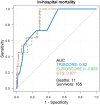TRI-SCORE: a single-centre validation study
- PMID: 37216902
- PMCID: PMC10244216
- DOI: 10.1093/icvts/ivad085
TRI-SCORE: a single-centre validation study
Abstract
Objectives: The TRI-SCORE is a recently published risk score for predicting in-hospital mortality in patients undergoing isolated tricuspid valve surgery (ITVS). The aim of this study is to externally validate the ability of the TRI-SCORE in predicting in-hospital and long-term mortality following ITVS.
Methods: A retrospective review of our institutional database was carried out to identify all patients undergoing isolated tricuspid valve repair or replacement from March 1997 to March 2021. The TRI-SCORE was calculated for all patients. Discrimination of the TRI-SCORE was assessed using receiver operating characteristic curves. Accuracy of the models was tested calculating the Brier score. Finally, a COX regression was employed to evaluate the relationship between the TRI-SCORE value and long-term mortality.
Results: A total of 176 patients were identified and the median TRI-SCORE was 3 (1-5). The cut-off value identified for increased risk of isolated ITVS was 5. Regarding in-hospital outcomes, the TRI-SCORE showed high discrimination (area under the curve 0.82), and high accuracy (Brier score 0.054). This score showed also very good performance in predicting long-term mortality (at 10 years, hazard ratio: 1.47, 95% confidence interval [1.31-1.66], P < 0.001), with high discrimination (area under the curve >0.80 at 1-5 and 10 years) and high accuracy values (Brier score 0.179).
Conclusions: This external validation confirms the good performance of the TRI-SCORE in predicting in-hospital mortality. Moreover, the score showed also very good performance in predicting the long-term mortality.
Keywords: Isolated tricuspid valve surgery; Risk scores; TRI-SCORE; Tricuspid regurgitation; Tricuspid valve disease.
© The Author(s) 2023. Published by Oxford University Press on behalf of the European Association for Cardio-Thoracic Surgery.
Figures







References
-
- Nath J, Foster E, Heidenreich PA.. Impact of tricuspid regurgitation on long-term survival. J Am Coll Cardiol 2004;43:405–9. - PubMed
-
- Topilsky Y, Nkomo VT, Vatury O, Michelena HI, Letourneau T, Suri RM. et al. Clinical outcome of isolated tricuspid regurgitation. JACC Cardiovasc Imaging 2014;7:1185–94. - PubMed
-
- Topilsky Y, Maltais S, Medina Inojosa J, Oguz D, Michelena H, Maalouf J. et al. Burden of tricuspid regurgitation in patients diagnosed in the community setting. JACC Cardiovasc Imaging 2019;12:433–42. - PubMed
-
- Enriquez-Sarano M, Messika-Zeitoun D, Topilsky Y, Tribouilloy C, Benfari G, Michelena H.. Tricuspid regurgitation is a public health crisis. Prog Cardiovasc Dis 2019;62:447–51. - PubMed
LinkOut - more resources
Full Text Sources

